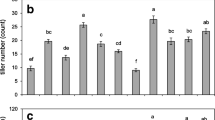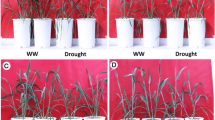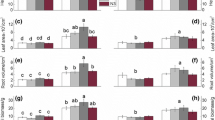Abstract
-
• Transplant shock, implicated by depressed seedling physiological status associated with moisture stress immediately following planting, limits early plantation establishment. Large root volume (Rv) has potential to alleviate transplant shock because of higher root growth potential and greater access to soil water.
-
• We investigated impacts of drought and transplant Rv on photosynthetic assimilation (A), transpiration (E), stomatal conductance (g s ), predawn leaf xylem water potential (ΨL), and growth of northern red oak (Quercus rubra L.) seedlings to explain mechanisms associated with susceptibility to transplant shock. One year-old barerooot seedlings were graded into four Rv categories and either well watered or subjected to drought consisting of low, medium, or high moisture stress by discontinuing irrigation at 22-day intervals for 3 months. Thereafter, all treatments were re-watered to examine recovery.
-
• Transplant shock was signified by reduced A, E, g s, and ΨL, which generally increased with increasing moisture stress and Rv. Physiological status improved during recovery, though stress was still evident in seedlings exposed to medium or high moisture stress and in larger Rv seedlings. Growth declined with increasing moisture stress but was generally similar among Rv treatments, likely reflecting greater A at the whole plant level and/or reliance upon stored reserves in large Rv seedlings.
-
• The most effective drought avoidance mechanisms were root growth, stomatal regulation, reduced leaf area, and higher growth allocation to roots relative to shoots. Our results suggest that large initial Rv does not enhance drought avoidance during the first season after transplant in northern red oak seedlings.
Résumé
-
• Le choc de transplantation, lié à l’état physiologique déprimé des plants associé à un stress hydrique, immédiatement après la plantation, limite le début de l’installation des plants. Un important volume racinaire (Rv) a le potentiel d’atténuer le choc de transplantation en raison du fort potentiel de croissance racinaire et d’un meilleur accès à l’eau du sol. Nous avons étudié les impacts de la sécheresse et des transplants Rv sur l’assimilation photosynthétique (A), la transpiration (E), la conductance stomatique (g s), le potentiel hydrique de base (ΨL), et la croissance des plants de chêne rouge (Quercus rubra L.) pour expliquer les mécanismes associés à la sensibilité à un choc de transplantation. Des plants de un an à racines nues ont été classés en quatre catégories Rv et soit bien arrosés, ou soumis à une sécheresse, consistant à un faible, moyen ou fort stress hydrique en cessant l’irrigation à 22 jours d’intervalle(27, 49 et 72 après la transplantation) pour 3 mois. Par la suite, tous les traitements ont été arrosés afin d’examiner la reprise.
-
• Le choc de transplantation qui généralement a augmenté avec l’augmentation du stress hydrique et Rv, a été significatif par la réduction de A, E, g s, and ΨL. L’état physiologique s’est amélioré lors de la reprise, même si le stress est encore évident chez les plants exposés à un stress hydrique moyen ou élevé et chez les plants à Rv les plus importants. La croissance a diminué avec l’augmentation du stress hydrique, mais elle a été généralement similaire chez les traitements Rv, reflétant probablement une plus grande A au niveau du plant entier et / ou le recours à des réserves stockées dans les plants à Rv important.
-
• Les mécanismes d’évitement de la sécheresse les plus efficaces ont été la croissance des racines, la régulation stomatique, une surface foliaire réduite et une allocation de la croissance plus élevée aux racines par rapport aux pousses. Nos résultats suggèrent que les grandes Rv initiales n’améliorent pas l’évitement de la sécheresse durant la première saison après transplantation chez les plants de chêne rouge.
Similar content being viewed by others
References
Anderson V.L. and McLean R.A., 1974. Design of experiments: a realistic approach, Marcel Decker Inc., New York.
Apostol K.G., Jacobs D.F., and Dumroese R.K., 2009. Root desiccation and drought stress responses of bareroot Quercus rubra seedlings treated with a hydrophilic polymer root dip. Plant Soil 315: 229–240.
Blake T.J., 1983. Transplanting shock in white spruce: effect of cold storage and root pruning on water relations and stomatal conditioning. Physiol. Plant. 57: 210–216.
Blake T.J., and Filho W.S., 1988. Drought tolerance, growth partitioning and vigor in eucalyptus seedlings and rooted cuttings. Tree Physiol. 4: 325–335.
Burdett A.N., 1990. Physiological processes in plantation establishment and development of specification for forest planting stock. Can. J. For. Res. 20: 415–427.
Burdett A.N., Herring L.J., and Thompson C.F., 1984. Early growth of planted spruce. Can. J. For. Res. 14: 644–651.
Carlson W.C., 1986. Root system consideration in the quality of loblolly pine seedlings. South. J. Appl. For. 10: 87–92.
Carlson W.C. and Miller D.E., 1990. Target seedling root system size, hydraulic conductivity and water use during seedling establishment. In: R. Rose, S.J. Camphell, and T.D. Landis (Eds.), Target seedling symp: Proc. Combined meeting of the Western For. Nursery Assocs. USDA For. Serv. Gen. Tec. Rep. RM-200. p. 53–65.
Dixon M., Le Thiec D., and Garrec J.P., 1995. The growth and gas exchange response of soil-planted Norway spruce [Picea abies L. (Karst)] and red oak [Quercus rubra L.] exposed to elevated CO2 and naturally occurring drought. New Phytol. 129: 265–273.
Grossnickle S.C., 1988. Planting stress in newly planted jack pine and white spruce. 2. Changes in tissue water potential components. Tree Physiol. 4: 85–97.
Grossnickle S.C., 2000. Ecophysiology of Northern Spruce Species: The performance of planted seedlings, NRC Research Press, Ottawa, Ontario, Canada. 409 p.
Grossnickle S.C., 2005. Importance of root growth in overcoming planting stress. New For. 30: 273–294.
Haase D.L. and Rose R., 1993. Soil moisture stress induces transplant shock in stored and un-stored 2 + 0 Douglas-fir seedlings of varying root volumes. For. Sci. 39: 275–294.
Hinckley T.M., Austin R.G., Aubuchon R.R., Metcalf C.L., and Roberts J.E., 1978. Leaf conductance and photosynthesis in four species of the oak-hickory forest type. For. Sci. 24: 73–84.
Jacobs D.F., 2003. Nursery production of hardwood seedlings. In Planting and care of fine hardwood seedlings, Hardwood tree improvement and regeneration center, West Lafayette, IN, USA, 8 p.
Jacobs D.F., Rose R., Haase D.L., and Alzugaray P.O., 2004a. Fertilization at planting impairs root system development and drought avoidance of Douglas-fir (Pseudotsuga menziesii) seedlings. Ann. For. Sci. 61: 643–651.
Jacobs D.F., Ross-Davis A.L., and Davis, A.S., 2004b. Establishment success of conservation tree plantations in relation to silvicultural practices in Indiana, USA. New For 28: 23–36.
Jacobs D.F., Salifu K.F., and Seifert J.R., 2005. Relative contribution of initial root and shoot morphology in predicting field performance of hardwood seedlings. New For 30: 295–311.
Johnson P.S., Novinger S.L., and Mares W.G., 1984. Root, shoot, and leaf area growth potentials of northern red oak planting stock. For. Sci. 30: 1017–1026.
Jones M.M., Turner N.C., and Osmond C.B., 1981. Mechanisms of drought resistance. In: Paleg L.G. and Aspinal D. (Ed.), The physiology and biochemistry of drought resistance in plants, Academic press, Sydney, pp. 15–35.
Levitt J., 1972. Responses of plants to environmental stresses, Academic Press, New York, 697 p.
Meinzer F.C., 1982. The effect of vapor pressure on stomatal control of gas exchange in Douglas-fir saplings. Oecologia 54: 236–242.
Puértolas P., Pardos M., Dolores Jiménez M., Aranda I., and Alberto Pardos J., 2008. Interactive responses of Quercus suber L. seedlings to light and mild water stress: effects on morphology and gas exchange traits. Ann. For. Sci. 65: 611.
Romero P., Navarro J.M., Garcia F., and Ordaz P.B., 2004. Effect of regulated deficit irrigation during the pre-harvest period on gas exchange, leaf development and crop yield of mature almond trees. Tree Physiol. 24: 303–312.
Rose R., Atkinson M., Gleason J., and Sabin T., 1991a. Root volume as a grading criterion to improve field performance of Douglas-fir seedlings. New For. 5: 195–209.
Rose R., Gleason J., Atkinson M., and Sabin T., 1991b. Grading ponderosa pine seedlings for outplanting according to their root volume. West. J. Appl. For. 6: 11–15.
Salifu K.F., Apostol K.G., Jacobs D.F., and Islam M.A., 2008. Growth, physiology, and nutrient retranslocation in nitrogen-15 fertilized Quercus rubra seedlings. Ann. For. Sci. 65: 101.
Sander I.L., 1990. Northern red oak (Quercus rubra L.). In Silvics of North America: 2. Hardwoods. Tech. coords. R.M. Burns, and H.H. Bsarabara. Agriculture Handbook 654. USDA, For. Ser., Washington, DC, Vol. 2, 877 p.
Sands R., 1984. Transplanting stress in radiata pine. Aust. For. Res. 14: 67–72.
Sloan J.L. and Jacobs D.F., 2008. Carbon translocation patterns associated with new root proliferation during episodic growth of transplanted Quercus rubra seedlings. Tree Physiol. 28: 1121–1126.
Struve D.K., 1990. Root regeneration in transplanted deciduous nursery stock. HortSci. 25: 266–270.
Struve D.K. and Joly R.J., 1992. Transplanted red oak seedlings mediate transplant shock by reducing leaf surface area and altering carbon allocation. Can. J. For. Res. 22: 1441–1448.
Teskey R.O., Bongarten B.C., Cregg B.M., Dougherty P.M., and Hennessey T.C., 1987. Physiology and genetics of tree growth response to moisture and temperature stress: an examination of the characteristics of loblolly pine (Pinus taeda L.). Tree Physiol. 3: 41–61.
Vyse A., 1981. Growth of young spruce plantations in interior British Columbia. For. Chron. 57: 174–180.
Waters W.E., DeMars C.J. Jr., and Cobb F.W. Jr., 1991. Analysis of early mortality of Douglas-fir seedlings in postharvest plantings in Northwestern California. For. Sci. 27: 802–826.
Weber J.A. and Gates D.M., 1990. Gas exchange in Quercus rubra (northern red oak) during a drought: analysis of relations among photosynthesis, transpiration, and leaf conductance. Tree Physiol. 7: 215–225.
Author information
Authors and Affiliations
Corresponding author
Rights and permissions
About this article
Cite this article
Jacobs, D.F., Salifu, K.F. & Davis, A.S. Drought susceptibility and recovery of transplanted Quercus rubra seedlings in relation to root system morphology. Ann. For. Sci. 66, 504 (2009). https://doi.org/10.1051/forest/2009029
Received:
Revised:
Accepted:
Issue Date:
DOI: https://doi.org/10.1051/forest/2009029




